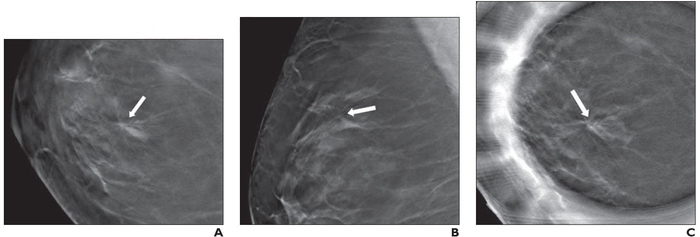Leesburg, VA, February 2, 2022—According to an article in ARRS’ American Journal of Roentgenology (AJR), imaging surveillance is a management alternative for architectural distortion on digital breast tomosynthesis (DBT) yielding radial scar without atypia and other concordant benign pathologies without atypia at biopsy.

Credit: American Roentgen Ray Society (ARRS), American Journal of Roentgenology (AJR)
Leesburg, VA, February 2, 2022—According to an article in ARRS’ American Journal of Roentgenology (AJR), imaging surveillance is a management alternative for architectural distortion on digital breast tomosynthesis (DBT) yielding radial scar without atypia and other concordant benign pathologies without atypia at biopsy.
“To our knowledge,” coauthors Juan Villa Camacho and Manisha Bahl of Massachusetts General Hospital in Boston contended, “this investigation represents the largest study of nonmalignant architectural distortion on DBT.”
Defining architectural distortion as parenchymal distortion with no visible mass, Camacho and Bahl’s retrospective study included cases of mammographically detected architectural distortion from July 1, 2016 to June 30, 2019 that were nonmalignant at image-guided needle biopsy and underwent surgical excision. Mammographic examinations included both digital 2D mammography and DBT. With imaging data extracted from radiology reports, upgrade rates were summarized using descriptive statistics.
The overall upgrade rate of architectural distortion on DBT with concordant nonmalignant pathology results at biopsy to malignancy at surgery was 10.2% (13/128). The upgrade rate to malignancy of architectural distortion without atypia at biopsy was 2.2% (2/89) and of architectural distortion with atypia was 28.2% (11/39).
Noting that, historically, surgery has been recommended for all cases of architectural distortion, including cases that are nonmalignant at biopsy, “our results suggest that imaging surveillance rather than surgery may be considered for radial scars without atypia and other benign concordant pathologies without atypia,” the pair concluded.
North America’s first radiological society, the American Roentgen Ray Society (ARRS) remains dedicated to the advancement of medicine through the profession of medical imaging and its allied sciences. An international forum for progress in radiology since the discovery of the x-ray, ARRS maintains its mission of improving health through a community committed to advancing knowledge and skills with the world’s longest continuously published radiology journal—American Journal of Roentgenology—the ARRS Annual Meeting, InPractice magazine, topical symposia, myriad multimedia educational materials, as well as awarding scholarships via The Roentgen Fund®.
MEDIA CONTACT:
Logan K. Young, PIO
44211 Slatestone Court
Leesburg, VA 20176
703-858-4332
Journal
American Journal of Roentgenology
DOI
10.2214/AJR.21.27161
Method of Research
Observational study
Subject of Research
People
Article Title
Management of Architectural Distortion on Digital Breast Tomosynthesis With Nonmalignant Pathology at Biopsy
Article Publication Date
2-Feb-2022
COI Statement
Author disclosures: Dr. Villa Camacho has no disclosures. Dr. Bahl is funded by the National Institutes of Health (K08CA241365). She is a consultant for Lunit (medical AI software company) and an expert panelist for 2nd.MD (digital health company). These relationships are not directly relevant to the submitted work.




